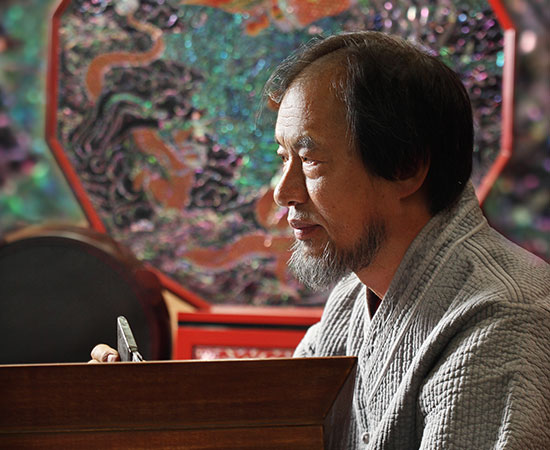Education/Research
National Heritage Story

September 1, 1954~ | Bearer Recognition : March 12, 2001
Lacquerware Making
Chiljang
A chiljang is an artisan who removes moisture and debris from the raw lacquer collected from sumac trees to increase its clarity and gloss and refine it for use. The lacquer, called ot, refers to the grayish-white fluid that oozes from the so-called sap glands and is technically considered a secretion in terms of plant physiology. The glands hold a certain amount of sap in normal times, and it flows out when the sumac tree is cut into. The sap that flows out and pools is called cheonyeonsaengchil, or natural raw lacquer. This is the basic material for all refined lacquer, and it is refined and processed into various types of lacquer such as raw lacquer, refined lacquer, black lacquer, transparent lacquer, and colored lacquer through filtering and refining processes. The sumac tree from which lacquer is harvested is native to Korea, China, Japan, Vietnam, Myanmar, Indonesia, Taiwan, etc. In general, lacquer is harvested from mid-June to mid-October, but when and how it is harvested varies from country to country due to the slight differences in geographical, natural, and environmental conditions. Lacquer is 60 to 80% hydrochloric acid, 10 to 30% water, 3 to 8% rubber, and 1 to 3% nitrogen substances. After drying, lacquer, which forms a film, is a polymeric substance that hardly changes even when immersed in strong acids such as hydrochloric acid, acetic acid, and aqua regia, or alkali, salt, or alcohol, and is superior to any other coating materials on earth in terms of adhesiveness, waterproofness, antiseptic efficiency, heat resistance, insulation, and durability. Therefore, lacquer is an eco-friendly coating with such excellent properties that it has been applied to metal and wood in Korea, China, and Japan since ancient times. Compared to chemical coatings such as paint and enamel, lacquer dries a little slower, but its hardness, glossiness, and adhesion are much better. In Korea, lacquer was mostly used on najeonchilgi, or lacquerware inlaid with mother-of-pearl. In addition to its function as a coating material, lacquer has also been found to be excellent as a medicinal material in many studies, and its benefits are described in detail in Bencao gangmu (known as Boncho gangmok in Korean; Compendium of Materia Medica) and Donguibogam: Principles and Practice of Eastern Medicine.
Lacquerware, a specialty of the East, is believed to have originated in China around 6,000 and 6,500 years ago, and it developed in different ways in Korea, China, and Japan. The use of lacquer in Korea can be traced back to the 3rd century BC, and the oldest lacquerware artifacts uncovered date back to the 1st century BC. Lacquerware, which underwent significant development during the Silla period, was combined with mother-of-pearl craftmaking during the Goryeo dynasty, and a new form of art called najeonchilgi (lacquerware inlaid with mother-of-pearl) emerged. During the Joseon dynasty, the state identified sumac habitats across the country and received lacquer from the producers, and most lacquer artisans in Seoul and the provinces worked in affiliation with the government.
Chiljang Jeong Su-hwa
Jeong Su-hwa was born on September 1, 1954 in Dapsimni, Dongdaemun-gu, Seoul to Mr. Jeong Gi-yeong and Ms. An Byeong-guk. After graduating from elementary school, he postponed going to middle school due to his family’s financial hardship and joined the workshop of his distant relative, Ju Hyeon-ho, to learn the art of najeonchilgi. While working as a lacquer worker, he learned the art of mother-of-pearl inlay. In 1971, when Ju’s workshop moved to Samyang-dong, he began working at the workshop of Lee Yun-gap, who had been the workshop manager, until he enlisted in the army. After completing his military service in 1978, he got married in the same year and later had one son and one daughter.
In 1979, he opened his own workshop, called Janganchilgi, in Jangan-dong. Although it was a small studio, he was able to continue producing his works. He relocated his workshop to Uijeongbu in 1985 and to Donong-dong, Namyangju in 1988. By working prolifically from 1986, he won a number of prizes including participation prizes, special prizes, as well as the Minister of Culture Award at the Korea Annual Traditional Handicraft Art Exhibition and the gold medal in the Najeonchilgi category at the National Skills Competition. In 1991, he received training from Shim Bu-gil (1906-1996), a master of najeonjang, and was officially recognized as a traditional skill transfer teacher’s assistant (currently called a traditional skill transfer educator) in 1994. In 1990, Kim Tae-hee founded the Korea Lacquer Culture Research Center, and Jeong learned how to refine lacquer, including the refining process and the use of additives, at the center. Jeong is an artisan who has been practicing traditional otchil and najeonchilgi for many years. By reviving the lacquer refining method that was lost due to the plundering of lacquer during the Japanese occupation period, Jeong has been contributing to the development of traditional Korean lacquer culture characterized by mesmerizing colors and gloss. In 2001, he was designated as a bearer of the National Intangible Cultural Heritage, chiljang, in recognition of his outstanding skills in drawing to finishing, as well as his craftsmanship in bringing forth high-quality refined lacquerware. In 2005, he was entrusted with the task of applying yellow lacquer to the memorial service table at Jongmyo Jeongjeon and is recognized as one of the best chiljang in Korea.
Works
- Moranmanchomunicheungnong (牧丹蔓草紋二層籠) _ 75×40×122 cm
After applying lacquer to a two-tier nong (chest) made of red pine and birch, the artist used mother-of-pearl to create the peony and vine patterns and applied several layers of lacquer on top.







